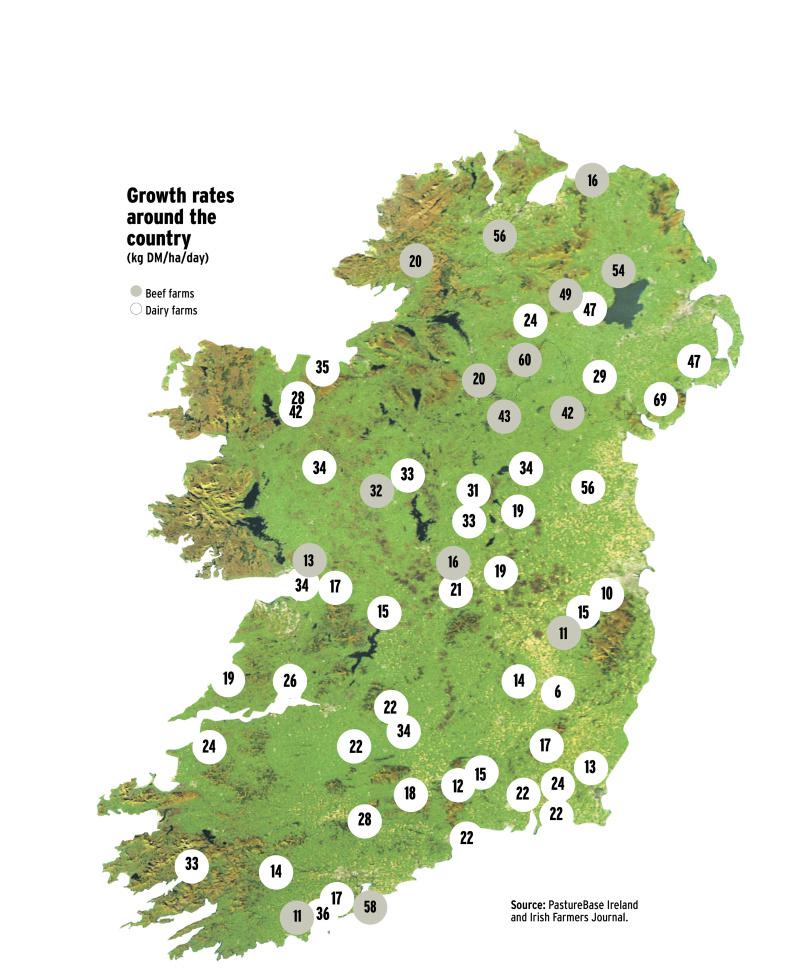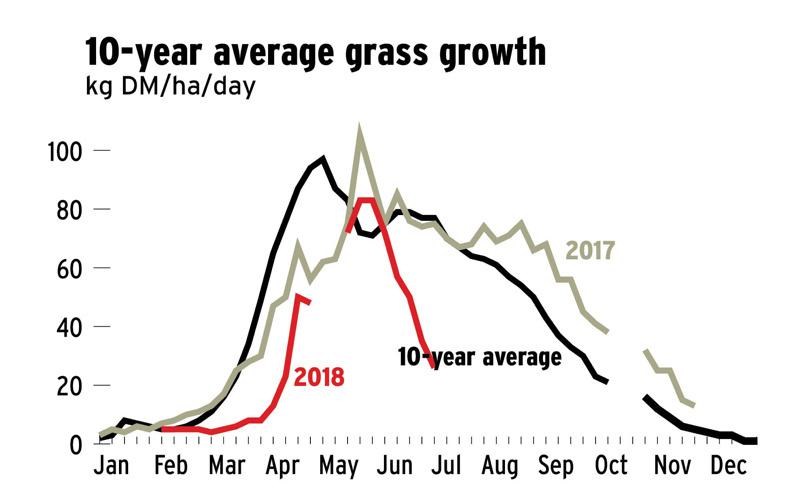This week, average growth rates have slipped to under 30kg DM/ha/day. What is perhaps more telling about how problematic the current grass situation is, however, is the fact that the number of farms measuring in the last week has dwindled significantly. Farmers in northern parts of the country are continuing to measure in high numbers, with many recording growth rates of over 40kg and 50kg DM/ha/day. On the other hand, farmers in the midlands and south have appeared to cease measuring for the time being, probably because growth rates are barely reaching double-digit figures.
Instead of measuring grass growth, many farmers’ time is now being spent ferrying bales from the yard to the fields.
Worryingly, this is leaving a significant dint in bale stocks for the coming winter. Where hay can be picked-up at €20 and €25 per round bale, it probably represents good value for money to keep cattle full.
The problem with hay is that while it may keep cattle from bawling at you, it is still a highly-fibrous feed stuff and its long-term feed benefits are minimal.
Therefore, it must be seriously considered if hay at €30 to €35 per bale is worth feeding to all stock.
Damage limitations
At this stage, concentrates could be as good of a feed option as any. With fodder prices rising significantly by the week and fodder extenders like palm kernel and soya hulls running low, the challenge now for farmers is to keep cattle full and performance up, all while keeping feed bills down. For example, forward store cattle, all finishing cattle, cull cows, empty cows and even weanling calves would be far better off supplemented on concentrates than on over-priced hay - at least the concentrates will be seen on their backs when the drought eventually does end.
Concentrates, with a lesser amount of wrapped silage will keep performance high. Suckler cows can undoubtedly be left on poorer silage or hay, but it is critical that their calves are getting access to creep; in the worst case scenario they will be ready for an early weaning and if it doesn’t come to that, at least they won’t suffer from a drop in milk yield.


Co Cork
System: Suckler to bull beef
Soil type: Heavy
Farm cover (kg DM/ha) 605
Demand (kg DM/ha/day) 33
Growth (kg DM/ha/day) 20
I have about 18 days of grass ahead of me. I decided about a week ago to extend the rotation length by giving bales of hay, which I bought, to the cows and calves. They get one round bale of hay every three days to restrict the amount of grass they are eating and to give the grass a chance to grow. I reckon I have enough hay to supplement, with grass to keep the cows fed for the next four to six weeks. To have sufficient feed for this winter I need to make sure I don’t graze the second-cut silage ground. I had planned to cut it at the end of July, but with the poor growth it won’t be fit to cut until mid-August, at best. I am pleased with the mid-season weight of all my calves; the bulls have had an ADG of 1.25kg and the heifers have done 1.05kg/day. To maintain this thrive on these animals I am letting them creep-graze ahead of the cows meaning they will get the best-quality grass.

Tullamore Farm Ltd
System: Suckler beef/sheep
Soil type: Mixed heavy and dry
Farm cover (kg DM/ha) 281
Demand (kg DM/ha/day) 19
Growth (kg DM/ha/day) 14
Tullamore Farm grew 14kg DM/ha this week. To put this into context, the farm grew 64kg DM/ha for the same week in 2017. There are currently eight days ahead of stock. There has been no significant rain on the farm in over a month and our driest paddocks have completely stopped growing. Some of the heavy paddocks are holding up well, but these have been closed for second-cut silage. All ewes have been weaned. Lambs are currently grazing some aftergrass and are being fed meal. Cows are on silage and calves are being offered meal under a creep fence. Meal feeding has increased to 4kg head/day to store heifers, along with silage. Days are being spent foddering and hauling water at the moment. A silage budget was completed this week and it’s estimated the farm will be 50-100t short. Bulls continue to be slaughtered out of the shed. Average carcase weight is 377kg, grading U-2+ with 57% killout at a gross price of €1,640.

Co Galway
System: Suckler to beef & dairy calf
Soil type: Free-draining loam
Farm cover (kg DM/ha) 479
Demand (kg DM/ha/day) 23
Growth (kg DM/ha/day) 8
Growth has completely stalled at this stage. I decided to cut my second-cut as it was beginning to head out. I was happy with the return of six bales per acre. I still need another 100 plus of silage before the start of the winter, but I’d be hopeful of getting a third cut if we could get rain at some stage. I’ve recently purchased hay and haylage in a bid to stretch fodder supplies. I’ve also started supplementing my Friesian steers at grass. I intended to sell them at the end of July, but the way trade has slipped I’ll have to keep them for longer. I’m hosting a BETTER farm beef challenge open day next Thursday, 19 July, with two walks on the day: one at 12pm and another at 5pm. Topics on the day will include how I’m managing with the current drought conditions, the financial performance of my farm and how I have been juggling AI with a full-time job. I am looking forward to the day and all are welcome to attend.

Co Kildare
System: Suckler calf/beef
Soil type: Free-draining
Farm cover (kg DM/ha) 295
Demand (kg DM/ha/day) 45
Growth (kg DM/ha/day) 11
With the continued dry spell there has been little or no grass growth over the past few weeks. As a result grass is starting to run out fairly quickly. All stock is being fed hay at grass to try and extend the grazing length in the paddocks to three days. I started to introduce 3kg of meal per day to the steers and heifers, which I hope to slaughter off grass at the end of the summer. Stock seem to be quite content in the heat. My dairy-bred calves are part of a Teagasc anthelmintic resistance study and are being monitored regularly for worm burdens and thankfully no significant burden has been detected as of yet. All these calves were given a dose of Vecoxan against Coccidiosis, as slight levels were detected, and since then they are doing very well. I scanned my cows last week and I am happy with how the breeding has gone for me. All my own suckler-bred calves were given a dose of Panacur for worms last week also.

Read more
Grass+: no letup to drought conditions
This week, average growth rates have slipped to under 30kg DM/ha/day. What is perhaps more telling about how problematic the current grass situation is, however, is the fact that the number of farms measuring in the last week has dwindled significantly. Farmers in northern parts of the country are continuing to measure in high numbers, with many recording growth rates of over 40kg and 50kg DM/ha/day. On the other hand, farmers in the midlands and south have appeared to cease measuring for the time being, probably because growth rates are barely reaching double-digit figures.
Instead of measuring grass growth, many farmers’ time is now being spent ferrying bales from the yard to the fields.
Worryingly, this is leaving a significant dint in bale stocks for the coming winter. Where hay can be picked-up at €20 and €25 per round bale, it probably represents good value for money to keep cattle full.
The problem with hay is that while it may keep cattle from bawling at you, it is still a highly-fibrous feed stuff and its long-term feed benefits are minimal.
Therefore, it must be seriously considered if hay at €30 to €35 per bale is worth feeding to all stock.
Damage limitations
At this stage, concentrates could be as good of a feed option as any. With fodder prices rising significantly by the week and fodder extenders like palm kernel and soya hulls running low, the challenge now for farmers is to keep cattle full and performance up, all while keeping feed bills down. For example, forward store cattle, all finishing cattle, cull cows, empty cows and even weanling calves would be far better off supplemented on concentrates than on over-priced hay - at least the concentrates will be seen on their backs when the drought eventually does end.
Concentrates, with a lesser amount of wrapped silage will keep performance high. Suckler cows can undoubtedly be left on poorer silage or hay, but it is critical that their calves are getting access to creep; in the worst case scenario they will be ready for an early weaning and if it doesn’t come to that, at least they won’t suffer from a drop in milk yield.


Co Cork
System: Suckler to bull beef
Soil type: Heavy
Farm cover (kg DM/ha) 605
Demand (kg DM/ha/day) 33
Growth (kg DM/ha/day) 20
I have about 18 days of grass ahead of me. I decided about a week ago to extend the rotation length by giving bales of hay, which I bought, to the cows and calves. They get one round bale of hay every three days to restrict the amount of grass they are eating and to give the grass a chance to grow. I reckon I have enough hay to supplement, with grass to keep the cows fed for the next four to six weeks. To have sufficient feed for this winter I need to make sure I don’t graze the second-cut silage ground. I had planned to cut it at the end of July, but with the poor growth it won’t be fit to cut until mid-August, at best. I am pleased with the mid-season weight of all my calves; the bulls have had an ADG of 1.25kg and the heifers have done 1.05kg/day. To maintain this thrive on these animals I am letting them creep-graze ahead of the cows meaning they will get the best-quality grass.

Tullamore Farm Ltd
System: Suckler beef/sheep
Soil type: Mixed heavy and dry
Farm cover (kg DM/ha) 281
Demand (kg DM/ha/day) 19
Growth (kg DM/ha/day) 14
Tullamore Farm grew 14kg DM/ha this week. To put this into context, the farm grew 64kg DM/ha for the same week in 2017. There are currently eight days ahead of stock. There has been no significant rain on the farm in over a month and our driest paddocks have completely stopped growing. Some of the heavy paddocks are holding up well, but these have been closed for second-cut silage. All ewes have been weaned. Lambs are currently grazing some aftergrass and are being fed meal. Cows are on silage and calves are being offered meal under a creep fence. Meal feeding has increased to 4kg head/day to store heifers, along with silage. Days are being spent foddering and hauling water at the moment. A silage budget was completed this week and it’s estimated the farm will be 50-100t short. Bulls continue to be slaughtered out of the shed. Average carcase weight is 377kg, grading U-2+ with 57% killout at a gross price of €1,640.

Co Galway
System: Suckler to beef & dairy calf
Soil type: Free-draining loam
Farm cover (kg DM/ha) 479
Demand (kg DM/ha/day) 23
Growth (kg DM/ha/day) 8
Growth has completely stalled at this stage. I decided to cut my second-cut as it was beginning to head out. I was happy with the return of six bales per acre. I still need another 100 plus of silage before the start of the winter, but I’d be hopeful of getting a third cut if we could get rain at some stage. I’ve recently purchased hay and haylage in a bid to stretch fodder supplies. I’ve also started supplementing my Friesian steers at grass. I intended to sell them at the end of July, but the way trade has slipped I’ll have to keep them for longer. I’m hosting a BETTER farm beef challenge open day next Thursday, 19 July, with two walks on the day: one at 12pm and another at 5pm. Topics on the day will include how I’m managing with the current drought conditions, the financial performance of my farm and how I have been juggling AI with a full-time job. I am looking forward to the day and all are welcome to attend.

Co Kildare
System: Suckler calf/beef
Soil type: Free-draining
Farm cover (kg DM/ha) 295
Demand (kg DM/ha/day) 45
Growth (kg DM/ha/day) 11
With the continued dry spell there has been little or no grass growth over the past few weeks. As a result grass is starting to run out fairly quickly. All stock is being fed hay at grass to try and extend the grazing length in the paddocks to three days. I started to introduce 3kg of meal per day to the steers and heifers, which I hope to slaughter off grass at the end of the summer. Stock seem to be quite content in the heat. My dairy-bred calves are part of a Teagasc anthelmintic resistance study and are being monitored regularly for worm burdens and thankfully no significant burden has been detected as of yet. All these calves were given a dose of Vecoxan against Coccidiosis, as slight levels were detected, and since then they are doing very well. I scanned my cows last week and I am happy with how the breeding has gone for me. All my own suckler-bred calves were given a dose of Panacur for worms last week also.

Read more
Grass+: no letup to drought conditions












 This is a subscriber-only article
This is a subscriber-only article









SHARING OPTIONS: